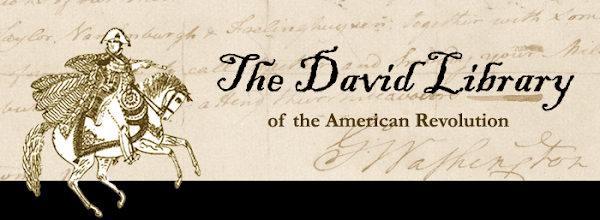By Erin Weinman
My internship
at the David Library ends today, and when I look back
on the past six weeks, I think I was able to absorb much more
actual knowledge of life in Revolutionary America than any class could
ever allow me to learn.
Librarian Kathie Ludwig asked me to undertake a
very interesting task: transcribing a series of letters written by a Revolutionary War soldier named
Oliver Reed. The letters are part of a family
collection, and the current custodians permitted the David Library to digitize them. My job was
to make transcriptions so that Library patrons can enjoy easy access. At first, the letters were a
bit difficult to read, but as a history student, transcribing is an important skill I must acquire if I want to become a
historian.
The
letters ended up being one of the most fascinating series of personal accounts
I have ever read. I had the choice to write a research paper for my senior
capstone at Rutgers University, but I
chose instead to come to the David
Library to experience what it is like to be a historian, and nothing could be more “hands-on” than this project. Although my job was
simply to transcribe, I was able to
learn who Oliver was on a personal level. These were his words that I was reading, his
personal thoughts that he had shared privately with his wife. Once I finished
all the transcribing, I was eager to learn more about the man who had written
these letters and with help from Kathie and from Richard Wood, a volunteer at the
David Library, I was able to flesh out
the story of Oliver. We were all amazed at what came up, and I soon learned the fascinating history of Oliver’s regiment, including the fact that it marched through my
hometown of Somerville, New Jersey.
While many great American patriots
are well known, the letters allowed a peek into the life of an average soldier.
Oliver Reed of Pomfret, Connecticut first
enlisted in the army during Lexington where he served for 12 days. Before long,
he was a sergeant in the 20th Continental Regiment. His heartfelt
letters humanize a man who might
otherwise be lost to history, giving voice to his longing for his children, as
well as his cravings for pickles and cider, and they describe
his struggles with chronic illness. It’s a part of a soldier’s
life that is rarely seen when studying the American Revolution, and amazingly, the David Library’s collection allowed
me to bring Reed’s story to
fuller life in relation to the ongoing war.
Born in 1745, Oliver married Betty
Force and moved to Pomfret in time for the birth of their first child, a daughter, Nabby. By 1776, Oliver
was off in Cambridge and marching to New York for the Battle of Long Island.
Using the letters of George Washington, soldier cards and a multitude of
secondary resources, I was able to piece together the
world of Oliver Reed by forming a
timeline of historical events including the siege of Philadelphia, the
battles of Trenton and Princeton, and eventually Valley Forge. Along the way, I discovered a lot about the 20th
Continental (later renamed Fourth Connecticut) Regiment and its leaders, Capt.
Beriah Bill, Capt. Stephen Brown and Col. John Durkee.
The letters do more, however, than just piece
together a possible campaign trail. They
allow us to see what it was like to be an average soldier, or to be a woman on the home front. Oliver
himself was constantly sick
and repeatedly expressed his desire to go home, even just for a few
weeks. He wanted to provide for his family, send gifts to his children from
Boston and eat real food. “I want sum of your pickels to Eat Long with Cold
meat”, he wrote. “I want sum
sider too”.
The
home front was perhaps even more tragic. In August 1777, Betty wrote to Oliver
about the deaths of two of their children. Records show that a third child died
just days after the letter was written. Betty had
little support and relied on the help of neighbors for milk and wood.
Eventually, she took her surviving son, Oliver Jr., and moved him to her
in-laws’ in Wrentham, Massachusetts.
I’m
pleased to report that I was invited to write an article about the Oliver Reed
letters for the website allthingsliberty.com (Journal of the American
Revolution). My article
follows the lives of Oliver and Betty as the war continued. The emergence of Oliver’s letters reveals a previously undiscovered story
that illuminates the life of a common Revolutionary era soldier. Special
thanks to both Richard and Kathie
for their help with this project. It was an
opportunity I never thought I would have as an undergraduate. The article is scheduled to be published on allthingsliberty.com
this August.
The Oliver Reed Letters, a part of
the David Library Digital Archives, are currently being curated. The Library will be making the digital
letters available to researchers in the near future.





